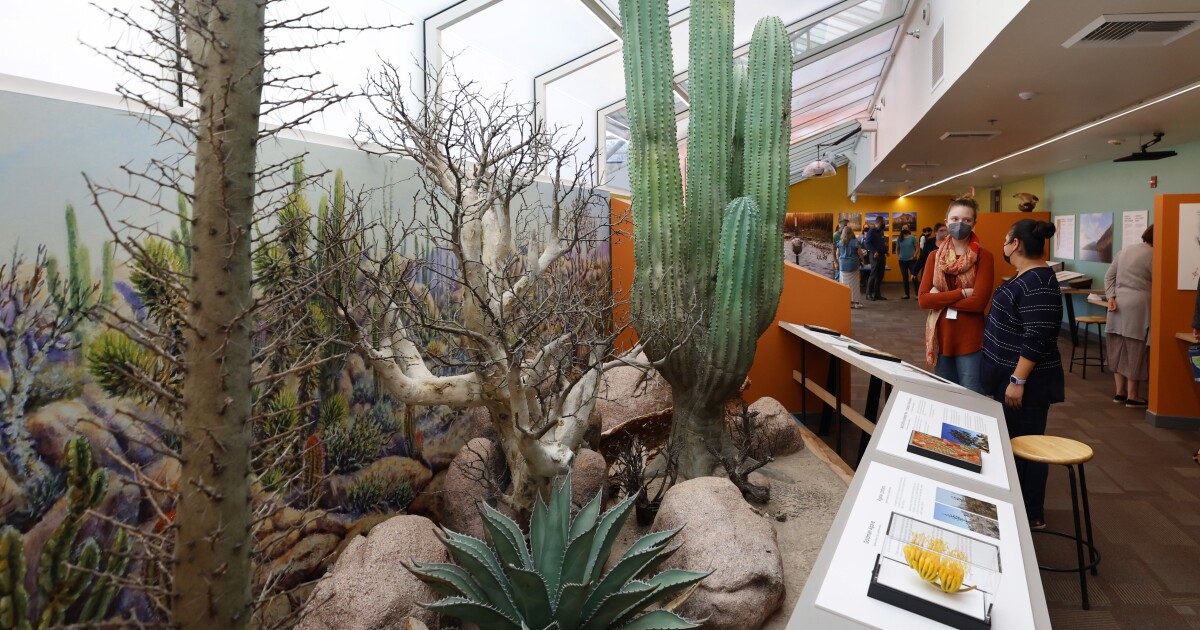
At the San Diego Natural History Museum’s new “Expedition Baja” exhibit, the journey begins with 2,000 square feet of converted office space.
The Balboa Park museum’s newest permanent exhibition opened yesterday in a new gallery on The Nat’s top floor. What used to be six staff offices is now a light-filled space dedicated to the 775 biodiverse miles of the Baja California Peninsula.
It is also a continuation of the museum’s march toward a more sustainable, science-forward, Nat-fueled future.
“We are leading with our science to open a whole series of exhibitions based on our collections and featuring our collections,” said Michael Field, the museum’s director of experience design.
“We are coming out of a period of renting traveling exhibitions, many of them not related to our region. We are sitting on 8 million objects here, and only a tiny amount of them have been visible in the past. Leading with our collection and our research is going to be our guiding light.”
The “Expedition Baja” tour officially starts outside the entrance, where a new mural by Tijuana-based street artist Néstor “Spel” Mondragón provides a colorful introduction to the plant and animal wonders on display inside.
Behold the rare Goldman agaves, which are only found in Baja California’s coastal succulent scrub and central desert. Check out the dune scorpions, which are thriving in Baja’s threatened sand dunes. And feel free to cozy up to the San Quintín kangaroo rat, which was thought to be extinct, until a binational team that included scientists from the Natural History Museum rediscovered it in 2017.
Whether it is a display dedicated to the successful cross-border effort to save the California red-legged frog, a specimen of the long-extinct Guadalupe caracara bird collected in 1875, or stunning photographs of the richly diverse San Pedro Mártir mountains, the “Expedition Baja” exhibit taps into The Nat’s vast resources to give visitors an in-depth look at the great swath of territory between Tijuana and Cabo San Lucas.
For San Diegans, those many miles are sort of our version of flyover country. For scientists, researchers and conservationists, it’s a goldmine. One that needs to be preserved so its natural wealth can be shared for generations to come.
“We are so connected to the Mexican culture here. It can’t go unnoticed how much it influences our day-to-day lives. The same goes for the wild animals and plants that are also connected to our region. Baja is the other half of our research mission,” said Bradford Hollingsworth, the museum’s curator of herpetology.
“I would like people to go beyond the day-to-day interaction of eating a good fish taco to thinking about the whole landscape connection. Biodiversity is sort of our key ingredient to the ecological balance on the planet. That has long been studied and proven again and again to be a critical component for a healthy environment and healthy cities.”
Like The Nat’s award-winning “Coast to Cactus in Southern California,” a permanent exhibition celebrating our beaches, deserts and mountains, “Expedition Baja” is a homegrown project that explores our nearby natural world from the ground up. And like the “Unshelved: Cool Stuff from Storage” and “Extraordinary Ideas from Ordinary People: A History of Citizen Science” exhibits, the museum digs into its ginormous collection to do it.
The display devoted to the 2017 discovery of not-extinct San Quintín kangaroo rat, which came almost 30 years after the last official sighting, includes kangaroo-rat specimens collected in 1925 and 1947. Since then, more of the kangaroo rats have been found in nature reserves protected by the Ensenada-based Terra Peninsular conservancy organization, and the museum is working with Terra Peninsular on conserving and protecting the species.
The section documenting the human-assisted decimation of the Isla Guadalupe — where introduced goats, cats and other invasive animals trampled native plants and hunted nesting birds — includes the 1875 caracara specimen and a specimen of the possibly extinct Guadalupe storm-petrel sea bird collected in 1897. The removal of feral goats in 2007, along with other invasive-animal measures, have helped the volcanic island stage a comeback.
While “Expedition Baja” is highlighting items from the museum’s storied past, it is also putting the spotlight on the scientists and researchers making news now.
Follow the recorded sounds of nighttime ribbiting, and you will find the exhibit’s California red-legged frog display. In 2016, one year before the discovery of the kangaroo rat, the museum teamed with the Mexican conservation organization Fauna del Noroeste to survey and conserve Baja’s remaining populations of California red-legged frogs, which have almost completely disappeared from our state.
Now, thanks to efforts of researchers on both sides of the border, new habitats are being built, and more than 6,000 eggs have been released into two new Southern California breeding ponds.
From the sustainably savvy use of upcycled fallen local trees and carpet tiles made from recycled materials, to the display of the gear, gadgets and snacks that researchers take on their field trips, every detail of “Expedition Baja” serves the museum’s mission to honor and conserve what’s left of the natural world and to acknowledge the work of the people who are making the miracles happen.
The footprint is small, but the vision is sweeping.
“There are a lot of stories being told here,” Hollingsworth said, as he looked around the bright, narrow space. “And there are more stories to tell.”
The San Diego Natural History Museum is at 1788 El Pradoin Balboa Park. It is open Friday through Tuesday. Regular hours are 10 a.m. to 4 p.m., except on Fridays, when it is open until 10 p.m. for its summertime “Nat at Night” program, running through Sept. 2. Admission is $22 for adults; $18 for seniors, students and military with I.D.; and $12 for youth ages 3 to 17. Children ages 2 and under are free. Admission is half off on Fridays after 4 p.m. Call (877) 946-7797 or go to sdnhm.org for information.